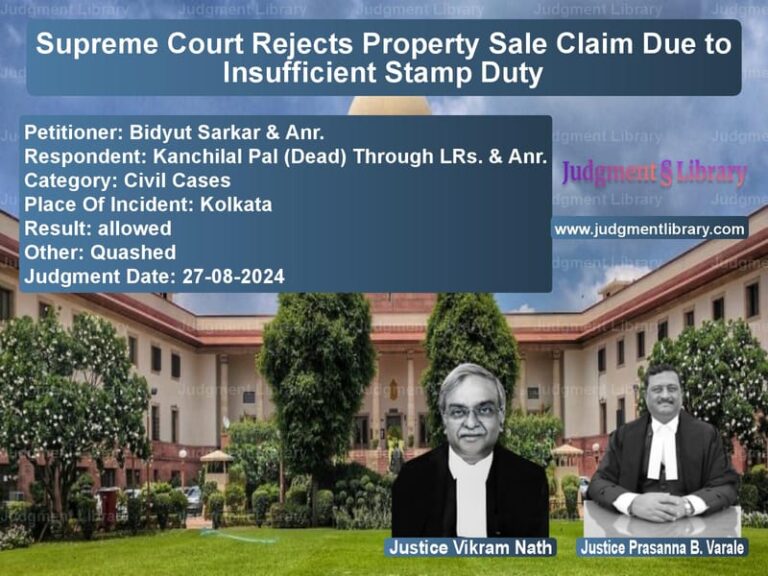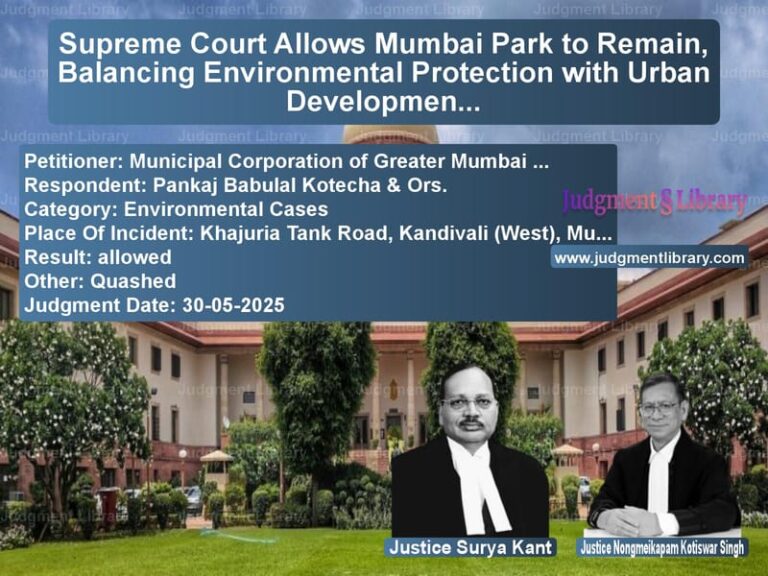Ramanand @ Nandlal Bharti v. State of Uttar Pradesh – Analysis of Circumstantial Evidence and Conviction
This case concerns an appeal by Ramanand @ Nandlal Bharti against his conviction for the murder of his wife and four children in 2002. The appellants had been sentenced to death by the trial court, which found Ramanand guilty based on circumstantial evidence, including an extra-judicial confession and the discovery of a weapon. The prosecution contended that the murders were motivated by Ramanand’s desire to marry Manju, which his wife opposed. However, the appellant raised concerns over the validity of the extra-judicial confession, the reliability of the evidence, and the fairness of the trial.
Petitioner and Respondent Arguments
Petitioner’s Arguments:
- The appellant, represented by senior counsel, argued that the conviction was based on weak and unreliable circumstantial evidence. The extra-judicial confession allegedly made by Ramanand was contested on the grounds that it was not made voluntarily and should not be used as a basis for conviction. The defense further argued that the discovery of the weapon was insufficient to prove Ramanand’s involvement in the murder.
- The appellant also argued that the prosecution failed to establish a clear motive for the murders, as the claim of the appellant’s desire to marry another woman was speculative and not supported by strong evidence. The defense contended that the trial court had relied on flawed evidence to convict the appellant.
Respondent’s Arguments:
- The prosecution, represented by the State of Uttar Pradesh, argued that the circumstantial evidence, including the extra-judicial confession, was sufficient to establish Ramanand’s guilt beyond a reasonable doubt. The prosecution pointed out that the confession was made to multiple witnesses and that the discovery of the weapon linked the appellant to the crime.
- The prosecution also argued that the motive for the crime was clear—Ramanand wanted to marry Manju, and the opposition of his wife was a strong motive for the murders. The prosecution contended that the evidence provided a strong case for conviction, and the death penalty was warranted given the brutal nature of the crime.
Key Issues and Supreme Court’s Ruling
The Supreme Court addressed several key issues in this case:
1. Validity of the Extra-Judicial Confession
The Court examined the validity of the extra-judicial confession and whether it could be relied upon to convict the appellant. The Court discussed the principles governing extra-judicial confessions and emphasized that such confessions should be voluntary and made in a credible manner. The Court referred to previous judgments, such as *State of Uttar Pradesh v. Rajesh* (2005), where it was held that an extra-judicial confession should be corroborated by other evidence to be admissible.
The Court found that while the appellant had made an extra-judicial confession, the circumstances surrounding its making raised questions about its authenticity. The Court held that there was insufficient corroborative evidence to support the confession, and thus, it could not be relied upon as the sole basis for the conviction.
2. The Discovery of the Weapon
The Court considered the evidence relating to the discovery of the weapon used in the murders. The prosecution argued that the discovery of the weapon linked the appellant to the crime. However, the Court noted that the recovery of the weapon, without further evidence of the appellant’s involvement in the murders, did not establish his guilt beyond a reasonable doubt. The Court emphasized that the prosecution needed to establish a clear chain of events linking the weapon to the appellant’s actions.
3. The Motive for the Crime
The Court also reviewed the prosecution’s argument regarding the motive for the crime. The prosecution contended that the appellant had murdered his family to marry another woman, Manju, whom his wife opposed. The Court found that while the motive was plausible, it was not conclusively proven. The Court emphasized that the prosecution had failed to establish the motive beyond a reasonable doubt, which weakened the case for conviction.
4. Death Penalty and Alternative Punishment
The Court also considered the appropriateness of the death penalty. The appellant contended that the death penalty was disproportionate to the crime, as there was insufficient evidence to support a conviction for murder. The Court acknowledged the brutal nature of the crime but ultimately found that the evidence was not strong enough to justify the death penalty. The Court commuted the sentence to life imprisonment, citing the lack of conclusive evidence and the importance of ensuring that justice is served through a fair trial.
Conclusion
The Supreme Court allowed the appeal and set aside the conviction for murder, ruling that the circumstantial evidence was insufficient to establish the appellant’s guilt beyond a reasonable doubt. The Court held that the extra-judicial confession and the discovery of the weapon were not corroborated by sufficient evidence to support a conviction for murder. The Court commuted the death sentence to life imprisonment, finding that the evidence did not justify the death penalty.
This judgment serves as a reminder of the importance of ensuring that criminal convictions are based on strong and reliable evidence, particularly in cases involving the death penalty. The ruling underscores the Court’s commitment to ensuring that justice is served fairly, even in the most serious cases.
Impact and Implications
This decision has significant implications for criminal cases involving circumstantial evidence and extra-judicial confessions. It emphasizes the need for corroborative evidence to support confessions and highlights the importance of a fair trial in determining guilt. The ruling also serves as a reminder of the Court’s careful consideration when imposing the death penalty, ensuring that it is only applied in cases where the evidence is overwhelming and irrefutable.
Petitioner Name: Ramanand @ Nandlal Bharti.Respondent Name: State of Uttar Pradesh.Judgment By: Justice Dhananjaya Y Chandrachud, Justice Hima Kohli.Place Of Incident: Uttar Pradesh.Judgment Date: 13-10-2022.
Don’t miss out on the full details! Download the complete judgment in PDF format below and gain valuable insights instantly!
Download Judgment: ramanand-@-nandlal-b-vs-state-of-uttar-prade-supreme-court-of-india-judgment-dated-13-10-2022.pdf
Directly Download Judgment: Directly download this Judgment
See all petitions in Murder Cases
See all petitions in Fraud and Forgery
See all petitions in Bail and Anticipatory Bail
See all petitions in Custodial Deaths and Police Misconduct
See all petitions in Judgment by Dhananjaya Y Chandrachud
See all petitions in Judgment by Hima Kohli
See all petitions in allowed
See all petitions in supreme court of India judgments October 2022
See all petitions in 2022 judgments
See all posts in Criminal Cases Category
See all allowed petitions in Criminal Cases Category
See all Dismissed petitions in Criminal Cases Category
See all partially allowed petitions in Criminal Cases Category







